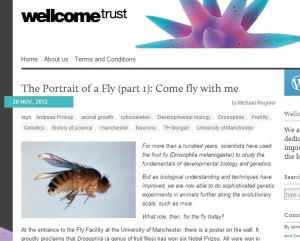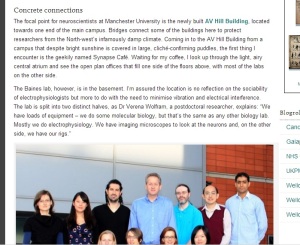The Fly: Behind the scenes
by Michael

Drosophila melanogaster. Credit: Anne Weston, LRI, CRUK, Wellcome Images.
I published two features – well, one pair of linked features – about fruit flies this week. The pieces were in many ways an experiment, and in other ways an indulgence.
The experiment first: we are moving towards more longform feature writing at work and it is probably important that we play with what that might mean in order to learn what we want it to mean or what we are capable of meaning it to mean. The buzzword is ‘explanatory’ writing, but not in the textbook vein: rather, focused on narrative and letting the ‘science’ come through more ‘palatable’ stories of people and their lives. The length is necessary to go into any level of detail; the form is what carries the reader through the detail – and the length.
My features this week did not really tell stories. I mean, the first one related the history of fruit flies over 100 years and more of research, with a little bit of fly physiology thrown in, before focusing on one lab in Manchester where they use fruit flies to learn about cells and how they work. The head of that lab was very keen on extolling the virtues of fly research, so I let his ‘evangelism’ carry the second half. But it was more of a snapshot, a profile, a portrait, if you will.
In the second feature, I again focused on one lab and its head, but the simple narrative was more about me going to visit and spending time there and getting to see some of the processes and techniques that are used in their research, which uses fruit fly larvae to understand more about nerve cells and their role both in development and in conditions like epilepsy. I found it fascinating being there, and I really hoped that readers would get a sense of that, if not their own fascination.
So often when writing about science, the bulk of the methodology is left undescribed, perhaps because no one asks the scientists about it, perhaps because they find their everyday tasks mundane, perhaps because we all assume readers will find them boring. But I wanted to see if there was any appetite for going into the detail of important (if no longer novel) techniques.
Each feature was around 3,000 words, which is at the short end of long, I suppose. But my concerns were that the content would not quite carry the reader for this length of reading commitment – that there was nothing inherently ‘special’ about these two labs, except that I had chosen to go and see them. I mean, I think they are both doing good work, and the potential is there for their findings to be important in various ways, but the ‘story’ of each feature was not particularly newsworthy or topical or hung on any other type of hook. The features as I wrote them did not work particularly hard to try to persuade the reader that these labs were ‘extraordinary’ – in many ways, I was interested in them because they were ‘ordinary’ (insofar as I find most science extraordinary) – but this doesn’t lend itself to grabbing readers and making the article a ‘must-read’.
Experiments in literature
I described these features as an experiment – but, as with so many arty types who use (or have foisted upon them) that word for their practice, this experiment was not a scientific one. The hypothesis, such as it was, was that delving into the motivations and methods of these labs would be of interest to readers. Was I really testing that hypothesis? How did I think I was going to measure ‘interest’? We can count how many people are tempted into clicking on the links to the features but not how many read the damn things, and certainly not whether they feel satisfied that they have done so. In the short-term t least, ‘hits’ and ‘page views’ are only a measure of your marketing skills, not your writing, which leaves me at a disadvantage because I hate selling and I hate selling myself above all.
 I saw some nice responses on Twitter, I’m pleased to say, but as with so many online things, the suspicion is that if what you write fits with what someone already thinks, or it provides them with fodder for their own pet arguments, they will approve of your work; if it doesn’t match their world-view, or – worse – is irrelevant to it, the main response is one of indifference.
I saw some nice responses on Twitter, I’m pleased to say, but as with so many online things, the suspicion is that if what you write fits with what someone already thinks, or it provides them with fodder for their own pet arguments, they will approve of your work; if it doesn’t match their world-view, or – worse – is irrelevant to it, the main response is one of indifference.
So I think the results of the experiment are inevitably inconclusive.
The French word for experiment is expérience, which also means experience. I mention this only because Émile Zola often described his novels as experiments, and I wonder if there is a more subtle meaning to the description in French. Speaking at SpotOn London the other week, Ben Goldacre described an experiment as making a change – any change – to the natural way of things and observing the results. In this sense, I think Zola’s novels could indeed be classed as experiments, either in the way that he established a world in his novels that he could perturb at will and let his imagination dictate the consequences, or in the fact that his novels were deliberately written to challenge the status quo and be the perturbation in the real world, creating an experience for his reader at the same time.
Could I apply a more rigorous interpretation of the desire to ‘experiment’ with my writing, and create articles designed to perturb either my reader’s understanding of things, or to perturb the way we science writers understand our own craft?
Indulgence in science writing
I only ever worked in a laboratory for a few months, as part of my undergraduate degree. I can’t remember what I did in detail, except that it involved purified pig’s blood and an inordinate number of Western blots that required 48 hours in a freezer to develop. I did not often get meaningful results, which was frustrating and put me off research, I suppose. I didn’t know that a low success rate for experiments was not uncommon, but even if I had, that fact alone might have put me off anyway.
However, I love going to meet scientists and I generally fall for them a little bit every time. There’s something very honest about the scientific endeavour, which means that most scientists are happy to talk to you about what they do, are pretty open about what they do and why they are doing it, and while there can sometimes be an ‘ulterior’ motive in wanting to artificially raise their profile, it generally comes after their desire to just talk about their science. After all, you’d be hard pushed to be any good at doing research if you didn’t believe in it and think it was among the most important, creative and worthwhile activities available to you. Tapping into that motivation is what we need more of when we are profiling scientists in longform articles.
 So when I went to Manchester, not knowing exactly what I would find, I was keen that I for once go beyond the standard practice (for me, previously) of simply interviewing the principal investigator (PI). I specifically asked to spend time in their labs and see what went on. I was hoping to find some additional stories or depth to the story of their research. Of course, this was a pretty meagre approach, considering that interviews with writers for The Paris Review are often conducted over multiple meetings, for hours at a time; whereas other longform features are the result of hundreds of miles travelling to talk to people and get every possible angle covered (even if not all of those interviews are directly apparent in the finished article).
So when I went to Manchester, not knowing exactly what I would find, I was keen that I for once go beyond the standard practice (for me, previously) of simply interviewing the principal investigator (PI). I specifically asked to spend time in their labs and see what went on. I was hoping to find some additional stories or depth to the story of their research. Of course, this was a pretty meagre approach, considering that interviews with writers for The Paris Review are often conducted over multiple meetings, for hours at a time; whereas other longform features are the result of hundreds of miles travelling to talk to people and get every possible angle covered (even if not all of those interviews are directly apparent in the finished article).
My trip to Manchester was great. I was shown around two labs, linked in their use of fruit flies to study an aspect of neuronal development, but actually very different – one being largely based on molecular and cellular biology techniques, the other grounded in electrophysiology. I think the element of time in the lab (and with researchers beyond just the PI) has to become a new standard practice (for me, in future) when researching longform features. It does provide experiences that can add depth to a piece. But maybe the trick will be to learn to recognise what is different in each lab; what is truly the aspect that makes it stand out? Or, on the other hand, simply what is of most relevance to the story.
With my fly features, I wanted to include everything I experienced, which is why it was an obvious indulgence to write them like that. Perhaps it also indulged the researchers involved, who were happy with the resulting articles (who wouldn’t like 3000 words on their work to be published?).
I can only hope there were some readers who felt indulged by being able to read them.
Reblogged this on Michael Regnier and commented:
Some thoughts on the fly features from my personal blog.